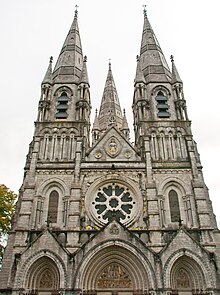Saint Fin Barre's Cathedral
| Saint Fin Barre's Cathedral, Cork | |
|---|---|
 |
|
| 51°53′40″N 8°28′50″W / 51.8944°N 08.48064°WCoordinates: 51°53′40″N 8°28′50″W / 51.8944°N 08.48064°W | |
| Country | Ireland |
| Denomination | Church of Ireland |
| Website | cathedral.cork.anglican.org |
| History | |
| Dedication | Saint Fin Barre |
| Architecture | |
| Architect(s) | William Burges |
| Style | Gothic revival |
| Groundbreaking | 1865+ |
| Completed | 1879 |
| Administration | |
| Diocese | Diocese of Cork, Cloyne and Ross |
| Province | Province of Dublin |
| Clergy | |
| Bishop(s) | The Right Reverend Paul Colton |
| Dean | The Very Revd Nigel Dunne |
| Precentor | The Dean of Cloyne |
| Chancellor | The Dean of Ross |
| Archdeacon | The Venerable Adrian Wilkinson |
| Laity | |
| Director of music | Peter Stobart |
| Organist(s) | James Taylor |
Saint Fin Barre's Cathedral, (Irish: Ardeaglais Naomh Fionnbarra) is a cathedral of the Church of Ireland in Cork city, Ireland. It is in the ecclesiastical province of Dublin. Begun in 1863, the cathedral was the first major work of the Victorian architect William Burges. Previously the cathedral of the Diocese of Cork, it is now one of three cathedrals in the Diocese of Cork, Cloyne and Ross.
The current cathedral is built on the site of at least two previous structures dedicated to Finbarr of Cork. The first dated from the 7th century, with works continuing through the 12th century. This building was damaged during the Siege of Cork (1690), and a new structure was built in 1735 - though elements of the earlier spire were retained.
This structure remained until the 1860s, when a competition for the building of a new larger cathedral was held 1862. In February 1863, the designs of the architect William Burges was declared the winner of the competition to build a new cathedral of St Fin Barre. His diary records his reaction - "Got Cork!" - whilst the cathedral accounts record the payment of the winning prize sum of £100. Building work took seven years before the first service was held in the cathedral in 1870. Building, carving and decoration continued into the 20th century, long after Burges's death in 1881.
The style of the building is Early French, Burges's favoured period and a style he continued to favour throughout his life, choosing it for his own home, The Tower House, in Kensington. The stipulated price for construction was to be £15,000, a sum vastly exceeded. The total cost came to significantly over £100,000. Burges was "unconcerned," writing to the Bishop of Cork in January 1877: "(In the future) the whole affair will be on its trial and, the elements of time and cost being forgotten, the result only will be looked at. The great questions will then be, first, is this work beautiful and, secondly, have those to whom it was entrusted, done it with all their heart and all their ability."
...
Wikipedia
